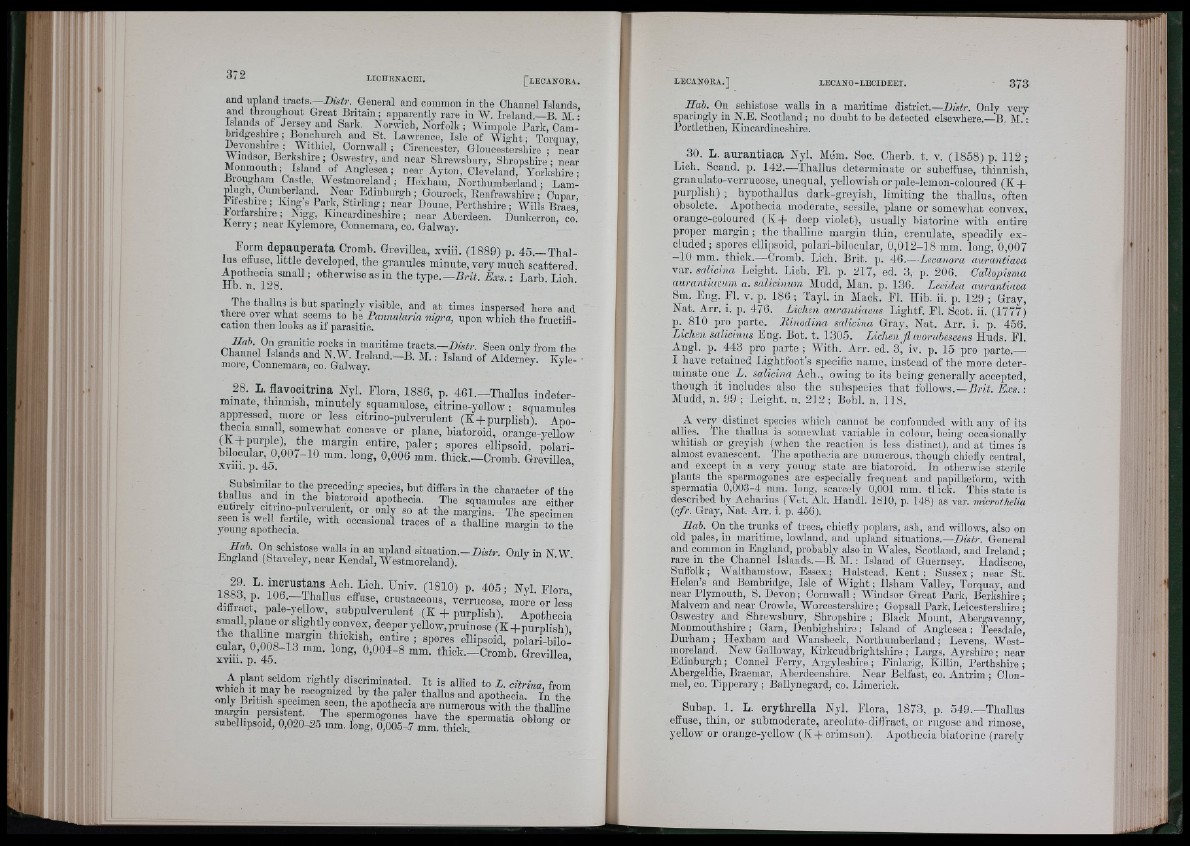
and upland tracts.—Diifr. General aud common in the Channel Islands,
and throughout Great Bntain; apparently rare iu W. Irelan d—B M •
Islands of Jersey and Sark. Norwich, Norfolk ; Wimpole Park, Cam-'
bndges u re ; Bonchurch and St. I.awrence, Isle of Wiglit; Torquay
Devoushire ; M ithiel Oornwall ; Cirencester, Gloucestershire ; near
Windsor Berkshire; Oswestry, and near Shrewsbury, Shropshire; near
Monmouth; Island of Anglesea; near Ayton, Cleveland, Yorkshire;
Broughara Castle Westmoreland ; Ilexham, Northumberland ; Lam?
plugh,_Cumberland Near Edinburgh ; Gourock, Renfrewshire ; Cupar,
Iife sh ire ; Rmg s Park, Stirling ; uear Donne, Perthshire ; Wills Braes
io rtarsliire; Nigg, lAmcardineshire ; near Aberdeen. Dunkerron, co
K e n y ; near Kylemore, Connemara, co. Galway.
Form depauperata Cromb. Grevillea, xviii. (1889) p. 45.—T hal-
lus effuse, little developed, the granules minute, very much scattered
Apothecia small ; otherwise as iu the typ e .— Brit. Exs. : Larb. Lich.
xiD. 11. 128,
The thallus is hut sparingly visible, and at times inspersed here and
theie over wliat seems to be Pannularia nigra, upon which the fructifi-
cation tiien looks as if parasitic.
tracts.—Di'sir. Seen only from the
Cliaunel Islands and N.W. Ireland.—B. JI. : Island of Alderney Kyle- •
more, Connemara, co. Gahvay.
28 L flavocitrina Nyl. Flora, 1886, p. 4 6 1 .-T h a llu s indeterminate,
thinnish, minutely squamulose, citrine-yellow ; squamules
appressed, more or less oitrino-pulverulent (K + purplish). Apotheoia
small somewhat concave or plane, biatoroid, orange-yellow
(X -k p u rp le) th e margin entire, p a le r; spores ellipsoid, polarix
v i i r j r i s Cromb. Grevillea,
th flto™ n n j'' Pl®.®®4ing species, but differs iu the character of the
thallus and m the biatoroid apothecia. The squamules are either
entirely citiano-pulverulent, or ouly so at the margins. The specimen
^
walls in an upland situ ation.-Dfsfr. Only in N.W
Englaud (Staveley, near Kendal, M’estmoreland).
1883, p. 106.—Thallus effuse, crustaceous, verruoose, more or less
diffract pale-yellow, subpulverulent (K -f purplish). Apothecia
small plane or sligh tly convex, deeper yellow, pruinose (K + p u rp lis h )
th e th alh n e margin thickish, entire ; spores ellipsoM, ¿o larf-bilocular,
0,008-1.3 mm. long, 0 ,0 0 4 -8 mm. thick.— Cromb Grevillea
xvm. p. 4-3. ijioviiiea,
A plant seldom rightly discriminated. I t is allied to L eitrina from
which It may be recognized 1^ the paler thallus and apoteecTa Æ
^ specimen seen, the apothecia are numerous with the thalline
Hah. Ou schistose walls in a maritime district.—Histr. Only very
sparingly in N.E. Scotland ; no doubt to be detected elsewhere.—^B, M. i
Portlethen, Kincardineshire.
30. L. aurantiaca Nyl. Mém. Soo. Cherb. t. v. (1868) p. 1 1 2 ;
Lich. Soand. p. 142.—Thallus determinate or subeffuse, thinnish,
graniilato-verruoose, unequal, j'cllowish or pale-lemon-coloured (K +
purplish) ; hypothallus dark-greyish, limiting the thallus, often
obsolete. Apothecia moderate, sessile, plane or somewhat convex,
orange-coloured (K + deep violet), usually biatorine with entire
proper margin ; the thalline margin thin, crenulate, speedily excluded;
spores ellipsoid, polari-bilooular, 0 ,0 1 2 -1 8 mm. long, 0,007
-1 0 mm. thiok.—Cromb. Lich. Brit. p. 46.—Lecanora aurantiaca
var. salieina Leight. Licb. Fl, p. 217, ed. 3, p. 206. Callopisma
aurantiacuin a. salicinum Mudd, Man. p. 136, Lecidea aurantiaca
Sm. Eng. Fl. v. p. 186 ; Tayl. in Maok. F l. Hib. ii. p. 129 ; Gray,
Nat. xlrr. i. p. 476. Lichen aurantiacus Lightf. F l. Soot. ii. (1777)
p. 810 pro parte. Kinodina salieina Gray, Nat. Arr. i. p. 456.
IJ c lu n salicinus Eng. Bot. t. 1305. U o h e n fl worubescens Huds. Fl.
Angl. p. 443 pro parte ; With. Arr. od. 3^ iv. p. 15 pro parte.—
I have retained Lightfoot’s specific name, instead of the more determinate
one L . salieina Ach., owing to its being generally accepted,
though it includes also the subspecies th a t follows.—HriT. E x s ■
Mudd, n. 99 ; Leight. n. 212 ; Bohl. n. I IS .
A very distinct species which caiiuot be confounded with any of its
allies. The thallus is somewhat variable iu colour, being occasionally
whitish or greyisli (yyheii the reaction is less distinct), and at times is
almost evanescent. The apothecia are numerous, though cliiefly central,
and except in a very youug state are biatoroid. In otherwise sterile
plants the .spermogones are especially frequeut and papillæforru, with
spermatia 0,003-4 mm. long, scarcely 0,001 mm. tl ick. This state is
described by Acharius (Vet. Ak. Handl. 1810, p. 148) as vait microthelia
{cfr. Gray, Nat. Air. i. p. 466).
Hab. On the trunks of trees, chieflv poplars, ash, aud willows, also on
old pales, iu maritime, lowland, and upland situations.—Disir. General
and common in England, probably also in Wales, Scotland, and Ireland ;
rare iu the Channel Islands.—B. M. ; Island of Guernsey. Hadiscoe,
Malvern and near Orowle, Worcestershire; Gopsall Park, Leicestershire;
Oswestry and Shrewsbury, Shropshire ; Black Mount, Abergavenny,
Monmouthshire; Garn, Denbighshire; Island of Anglesea; Teesdale,
Durham; Hexham and Wansbeck, Northumberland; Levens, Westmel,
CO. Tipperary ; Ballynegard, c o . Limerick.
Subsp. I. L. erythrella Nyl. Flora, 1873, p. 549.—Thallus
effuse, thin, or submoderate, areolato-diffract, or rugose and rimóse,
yellow or orango-yollow (K -f crimson). Apothecia biatorine (rarely
ii ! > l
I? 1